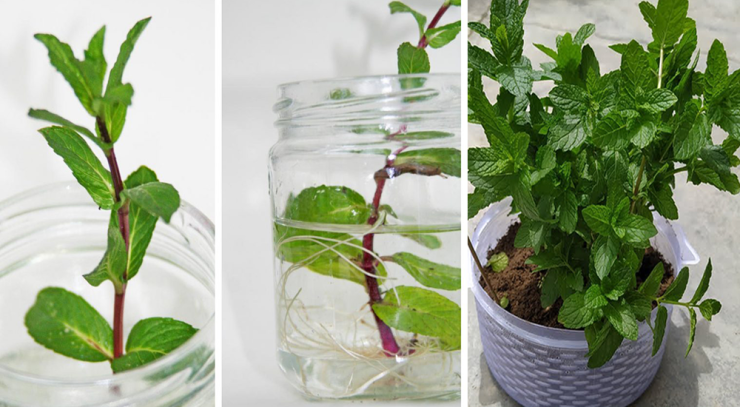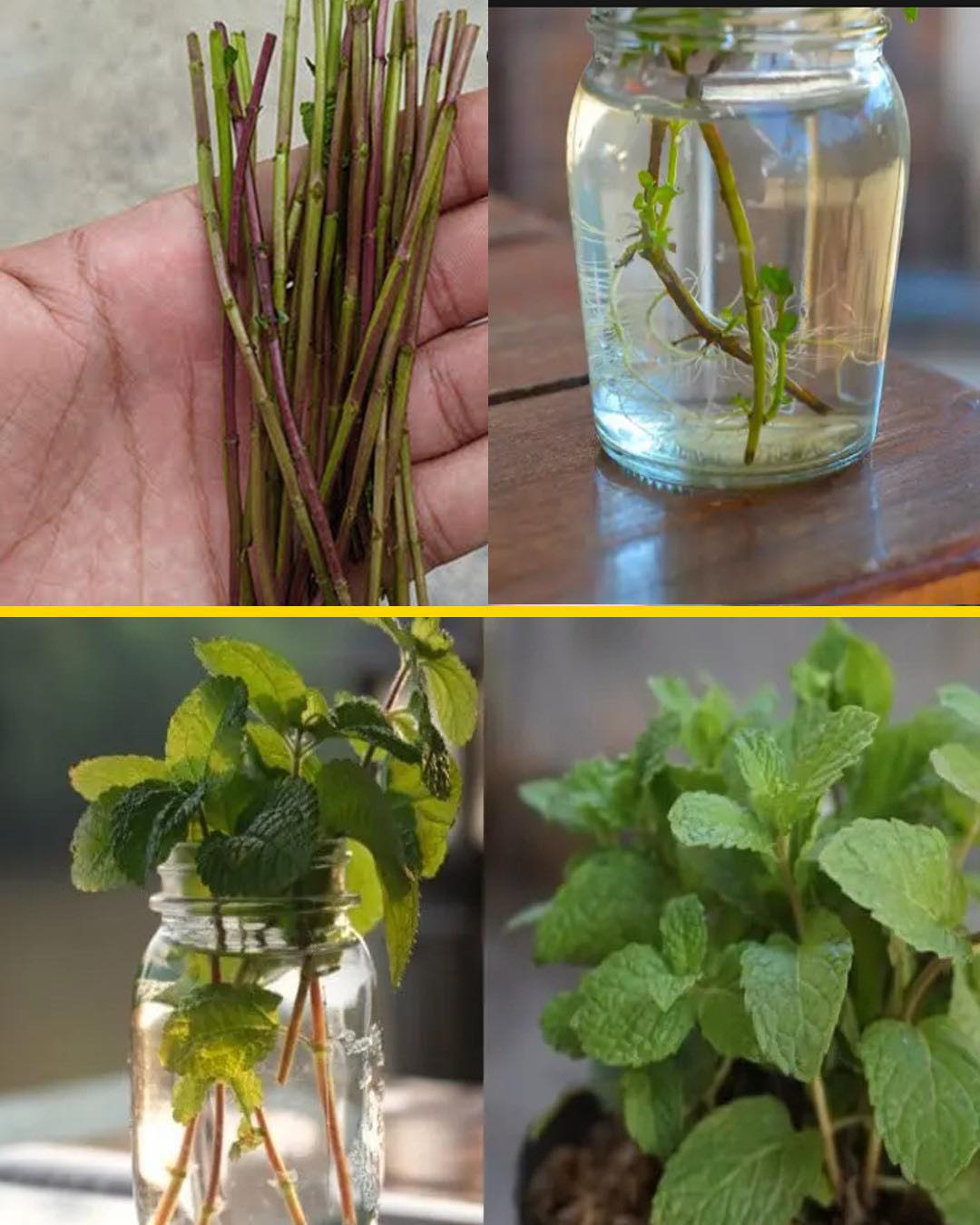Mint, with its refreshing aroma and versatility in culinary applications, is a beloved herb for many gardeners and cooks. It’s also one of the easiest herbs to propagate from cuttings in water. Whether you’re a seasoned gardener or a novice with a green thumb, this step-by-step guide will show you how to grow mint from cuttings in water, ensuring a steady supply of fresh mint for your culinary creations and aromatic delights.

Materials You’ll Need:
Before you start your mint-growing project, gather the following materials:
Mint Cuttings: Select healthy mint cuttings from an established mint plant. Choose stems that are at least 4-6 inches long and have several sets of leaves.
A Glass or Vase: You’ll need a clear glass or vase to hold the cuttings. This allows you to monitor the rooting progress.
Water: Use clean, room-temperature water. Avoid using water with added chemicals like chlorine, as these can inhibit root growth.
Scissors or Pruners: Use clean, sharp scissors or pruners to make precise cuts.
Indirect Sunlight: Mint cuttings need bright, indirect sunlight. Place your glass or vase in a location that receives filtered sunlight.
Step-by-Step Guide:
1.Prepare the Cuttings:
Start by taking several mint cuttings. Cut the stems just below a node, which is where the leaves are attached. Nodes are crucial for root formation. Remove any leaves from the lower part of the cutting, leaving just a few sets of leaves at the top.
2.Place the Cuttings in Water:
Fill your glass or vase with room-temperature water. Submerge the mint cuttings in the water, ensuring that the nodes are fully submerged.
3.Change the Water:
Change the water every few days to prevent the growth of algae and ensure a clean environment for root development. Trim the cut ends slightly when changing the water.
4.Provide Indirect Sunlight:
Place your glass or vase in a location with bright, indirect sunlight. Avoid direct sun, as it can lead to excessive evaporation and heat, which may stress the cuttings.
5.Monitor Root Growth:
Over the course of a few weeks, you will notice the development of roots from the nodes of the mint cuttings. This is a sign that your mint cuttings are ready for transplant.
6.Transplant into Soil:
Once your mint cuttings have developed roots that are at least a couple of inches long, they are ready to be transplanted into soil. Use a well-draining potting mix and plant the cuttings at the same depth as they were in the water.

7.Water and Care for Your Mint Plants:
After transplanting, water your mint plants and place them in a location with indirect sunlight. Mint prefers consistently moist soil, so water them regularly. Be sure to keep the soil well-draining to prevent root rot.
8.Harvest and Enjoy:
As your mint plants grow, you can start harvesting leaves for culinary use. Mint is known for its vigorous growth, so be prepared for a bountiful supply of fresh mint.
Growing mint from cuttings in water is a simple and rewarding process. Whether you’re looking to enhance your culinary creations or simply enjoy the refreshing fragrance of this herb, following these steps will help you cultivate a thriving mint garden in no time. With this guide, you’ll have the pleasure of watching your mint cuttings transform into thriving plants that you can enjoy for years to come. Happy gardening!
News
JJ Redick reacts to Luka Doncic trade for Anthony Davis
In one of the most jaw-dropping moves of the season, the NBA landscape was rocked by the blockbuster trade involving Luka Dončić and Anthony Davis—a swap that has sent ripples of excitement, disbelief, and heated discussion through the league. Among…
Anthony Davis FULL reaction to trade to Mavericks for Luka Doncic
In a blockbuster move that sent shockwaves through the NBA and left fans reeling, Anthony Davis has been traded to the Dallas Mavericks in exchange for Luka Dončić. In the immediate aftermath of the news, Davis took to the media…
Shaq reacts to Dallas Mavericks wanting Kevin Durant after Luka-AD trade 👀
In the constantly shifting world of the NBA, trade rumors and blockbuster moves are a regular part of the season’s drama. The latest twist has fans buzzing: the Dallas Mavericks have reportedly set their sights on acquiring Kevin Durant in…
Donovan Mitchell FILTHY poster dunk on Kristaps Porzingis 😳
In a game filled with high-intensity moments and jaw-dropping highlights, one play in particular has left fans and analysts buzzing about Donovan Mitchell’s latest display of athleticism. Early in the contest, with the atmosphere already charged by an evenly matched…
Joel Embiid hits go-ahead bucket vs Mavs then chats with Anthony Davis after game
In one of the most thrilling contests of the season, Joel Embiid delivered a clutch performance against the Dallas Mavericks, punctuating the game with a go-ahead bucket that sent the home crowd into a frenzy. The atmosphere in the arena…
D’Angelo Russell game winner as Nets hit two 3’s in 3 seconds to win vs Rockets 😱
In one of the most electrifying moments in recent NBA history, D’Angelo Russell delivered an unforgettable game-winner that left fans and commentators in complete awe. With the Brooklyn Nets locked in a tense battle against the Houston Rockets, the outcome…
End of content
No more pages to load











